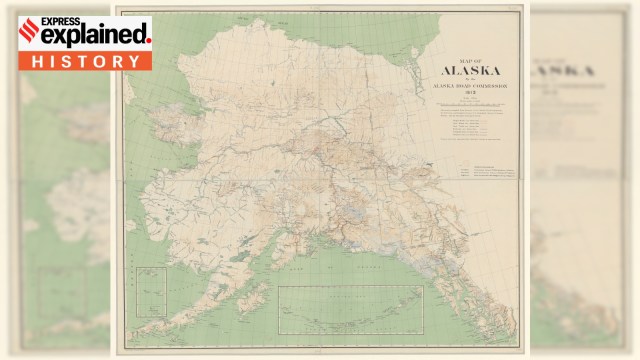
The Great Alaskan Gamble: How ‘Seward’s Folly’ Became America’s Arctic Jewel
By [Your Name/Journalist Name]
WASHINGTON D.C. – On a chilly spring morning, March 30, 1867, in the pre-dawn hours of a city still reeling from civil war, a quiet revolution was unfolding in the dimly lit office of Secretary of State William H. Seward. Amidst the ticking clocks and the scent of stale cigars, a deal of monumental, yet then-unfathomable, consequence was being struck: the United States would purchase the vast, frozen expanse of Alaska from Imperial Russia for $7.2 million.

It was a transaction that would be derided as "Seward’s Folly," "Seward’s Icebox," and "Johnson’s Polar Bear Garden." Critics in the press and Congress scoffed at the acquisition of what they saw as a barren wasteland, a remote wilderness of ice, snow, and polar bears. Yet, 157 years later, this audacious gamble stands as one of the most brilliant strategic moves in American history, transforming a perceived folly into an undisputed Arctic jewel, rich in resources and geopolitical significance.
Russia’s Burden, America’s Opportunity
To understand the audacity of the Alaska Purchase, one must first grasp the context of its sale. For Russia, Alaska – or Russian America, as it was then known – had become a burden. Acquired in the 18th century through exploration and fur trade, the territory was immense (over 586,000 square miles), remote, and difficult to defend. After the devastating Crimean War (1853-1856), Russia’s treasury was depleted, and the cost of maintaining its American colony was becoming prohibitive.
Furthermore, Tsar Alexander II and his foreign minister, Prince Alexander Gorchakov, harbored a deep fear: that in the event of another conflict, particularly with Great Britain, the Royal Navy would easily seize Alaska. Selling it to a friendly power, the United States, seemed a far better alternative than losing it outright to a rival. The thought of British Canada bordering Russian America was a strategic nightmare for St. Petersburg.
Enter William H. Seward, a visionary expansionist and the most experienced diplomat in President Andrew Johnson’s cabinet. A firm believer in Manifest Destiny, Seward had long dreamed of American dominion over the entire North American continent, envisioning a future where the U.S. flag flew from the Caribbean to the Arctic. He saw Alaska not as an empty icebox, but as a strategic gateway to the Pacific, a potential source of immense wealth, and a crucial step in America’s global ascendancy.
The Midnight Negotiation
The negotiations themselves were shrouded in secrecy and imbued with a sense of urgency. The Russian minister to the United States, Eduard de Stoeckl, was authorized to sell the territory. He and Seward had been discussing the possibility for some time, but the final push came on the night of March 29, 1867.
Stoeckl received a telegram from St. Petersburg granting him full authority to complete the sale. He immediately rushed to Seward’s home, finding the Secretary of State playing whist. "I have a dispatch, Mr. Seward, from my government, by this evening’s mail," Stoeckl reportedly declared, "The Emperor gives his consent to the cession, and now, if you like, you can conclude the treaty tomorrow."

Seward, known for his relentless work ethic, famously replied, "Why wait till tomorrow, Mr. Stoeckl? Let’s make the treaty tonight." And so, they did. Throughout the night, with clerks working by gaslight, the treaty was drafted and signed at 4:00 AM on March 30, 1867. The price agreed upon was $7.2 million, which, when calculated, amounted to approximately two cents per acre for a territory more than twice the size of Texas.
‘Seward’s Folly’ and Public Outcry
The ink on the treaty was barely dry before public opinion erupted in a torrent of ridicule. The nation was still recovering from the Civil War, grappling with Reconstruction, and many saw the purchase as an extravagant and nonsensical waste of taxpayer money. Newspapers lampooned Seward, depicting him as a madman buying ice and polar bears. The New York Tribune called it "an uninhabitable, frozen waste." Others dubbed it "Walrussia," "Seward’s Icebox," or "President Johnson’s Polar Bear Garden."
The New York Herald famously quipped, "The treaty was secretly negotiated and quietly signed, and the public are now called upon to ratify the act of a single individual, who has purchased a territory for us, of which we know nothing, but that it is a vast, worthless, and uninhabitable region."
Despite the widespread derision, Seward, with the support of President Johnson, tirelessly lobbied Congress for ratification. He presented compelling arguments, highlighting the strategic advantages of controlling the North Pacific, the potential for fishing and mineral wealth, and the removal of a European power from North American borders. The Senate, after a contentious debate, ultimately ratified the treaty on April 9, 1867, by a vote of 37 to 2. The House of Representatives, however, took more than a year to appropriate the funds, finally doing so in July 1868, amidst allegations of bribery (though never proven).
The Handover and Years of Neglect
The formal transfer of Alaska took place on October 18, 1867, at Sitka, the capital of Russian America. A somber ceremony unfolded, with Russian and American troops parading, and the Russian flag being lowered while the American flag was raised. The transition, however, was not seamless. Accounts describe the Russian flag getting caught in the ropes, requiring a sailor to climb the pole to free it, an ominous sign for some.
Following the purchase, Alaska entered a period often referred to as its "lost decades." The federal government, preoccupied with Reconstruction and westward expansion in the contiguous United States, largely neglected its new acquisition. For years, Alaska was administered first by the Army, then the Treasury Department, and later the Navy, lacking a coherent civil government or significant investment. Its vast resources remained largely undiscovered, and the population, primarily indigenous peoples and a few thousand American and European settlers, struggled with a lack of infrastructure and legal clarity.
The Klondike Gold Rush: A Turning Point
Seward’s critics remained vocal for decades, but the tide began to turn dramatically in the late 19th century. The discovery of gold in the Klondike region of Canada in 1896, and subsequent finds in Alaska itself (Nome, Fairbanks), triggered a massive gold rush. Thousands of prospectors, adventurers, and entrepreneurs flooded into the territory, bringing with them a new wave of American interest and investment. The gold, flowing south through Alaskan ports, validated Seward’s foresight and began to silence the "folly" narrative.
This was just the beginning. The 20th century unveiled Alaska’s true resource potential. Its waters teemed with some of the world’s richest salmon and crab fisheries. Its forests contained vast timber reserves. And beneath its frozen tundra lay colossal deposits of coal, copper, and, most significantly, oil and natural gas.
Oil, Strategy, and the Arctic Future
The discovery of massive oil reserves at Prudhoe Bay in 1968, and the subsequent construction of the Trans-Alaska Pipeline, cemented Alaska’s economic importance. It became a vital source of domestic energy, contributing significantly to America’s energy independence and national security. The revenues generated from oil transformed Alaska, funding public services and infrastructure development.
Beyond resources, Alaska’s strategic value grew exponentially during the Cold War. Bordering the Soviet Union across the Bering Strait, it became a crucial frontline for defense, hosting military bases and radar installations. Today, as the Arctic becomes increasingly accessible due to climate change, Alaska’s geopolitical importance continues to grow, positioning the United States as a key player in Arctic governance, shipping routes, and resource development.
A Legacy of Vision
From a "folly" to a "masterstroke," the Alaska Purchase stands as a testament to the power of long-term vision. Seward, who never lived to see the full realization of his dream (he died in 1872), famously remarked, "I know that it is a good treaty, and that I have made it with due deliberation, and with the full consent of the President. It is a work that will commend itself to the public judgment in a century hence." His words proved prophetic.
Today, Alaska is the largest state in the U.S. by area, a land of unparalleled natural beauty, vibrant indigenous cultures, and immense strategic significance. Its glaciers, national parks, and wildlife attract millions of tourists annually, while its resource industries continue to drive its economy.
The $7.2 million paid for Alaska, a sum equivalent to roughly $150 million in today’s money (a mere fraction of a modern military jet), was arguably the greatest real estate bargain in history. What was once seen as a frozen wasteland is now unequivocally recognized as a national treasure, a critical component of American power and prosperity, and a living monument to a diplomatic gamble that paid off handsomely. The echoes of "Seward’s Folly" have long faded, replaced by the roar of the Alaskan pipeline and the majestic silence of its wilderness – a testament to a truly visionary acquisition.


